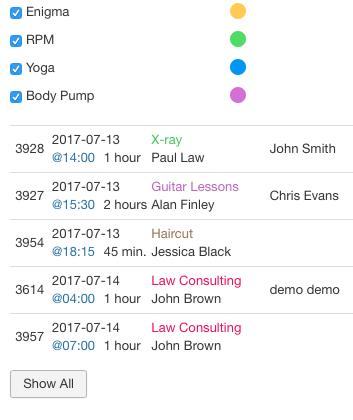Appointments
The Appointments section of VikAppointments contains the Reservations, the Waiting List, the Customers, the Coupons and the Calendars.
All the features contained in this section are used to manage the orders and the customers and to check the availability of your employees/services.
Reservations
All the stored orders/appointments are visible from this view. You can also create offline upcoming reservations (e.g. via telephone) with an intuitive calendar form. Every time an order is made from the front-end, the customer, the employee and the administrator(s) will be notified via e-mail.
You can print all the selected orders by clicking on the Print button in the Joomla toolbar.
It is possible to search the appointments by ID (by using the prefix id:), order key, customer name, customer e-mail, customer phone, coupon code, employee and service. It is also possible to filter the appointments by status, method of payment, location and checkin date. Once the check-in date filter is specified, another calendar field will appear, giving you the possibility of defining the end date of the range.
Order
- Order Number - an incremental identifier of the orders (integer). By hovering the mouse on the ID you will see who (& when) created the order.
- Order Key - an alphanumeric secret value used to search the orders by the customers (order number must be always specified).
- Payment - the gateway used (or to use) to pay the amount of the appointment. If the selected employee won't have custom payments, only the default ones could be selected.
- Status - the status of the appointment. Take a look at the Global - Status Codes section for further details.
- Notify Customer - check this option if you want to re-send a notification e-mail about the appointment only to the customer. The button next to this option, that appears when turning it on, can be used to include custom texts within the notification e-mail. When writing a text, it will be saved as new (unpublished) E-mail Custom Text so that it can be re-used in a second time.
- Notify Employee - check this option if you want to re-send a notification e-mail about the appointment only to the employee.
Billing
- Customer - select a user from the dropdown to assign a customer to the order and to auto fill-in all the details (nominative, mail and phone number). In case the user doesn't exist or its details are wrong, it is possible to click the button next to this field to insert/update a customer without having to leave the page.
- Nominative - the full name of the customer for this appointment.
- E-Mail - the e-mail address of the customer for this appointment. This value will be used to send e-mail notifications to the customer.
- Phone Number - the phone number of the customer for this appointment. This value will be used to send SMS notifications to the customer.
Appointments
To modify the details of the appointment, you have just to click the button and select the type of package. Here's possible to choose a different employee (among the ones that are available at the same date and time and for the same service), change the base price of the service and the duration and increase/decrease the number of participants (only if allowed by the selected service).
It is possible to modify the service and or the check-in date only by clicking the "Change" button, which will redirect you to the calendar page to restart the booking process.
The total cost of the appointment is automatically calculated according to the prices of the booked service, summed to the cost of the extra options. The Add Discount button can be used to maually apply a coupon code to the order.
Extra Options
It is possible to add extra options by clicking the related button below the total cost of the appointment. From here it is possible to choose the option to add, the variation (if any), the quantity and the base price (per unit).
Notes
While creating a new reservation, an editor will appear to enter some extra notes. After saving the reservation, the system will create a separated note for the appointment, readable only by the administrator.
While editing an existing reservation, from this section it is possible to see all the created notes and even create new ones.
Custom Fields
The custom fields filled-in from the customer during the purchase.
Every time a reservation is saved from the back-end and it is assigned to a specific user that owns a package, the system will automatically try to redeem it. This will happen only in case the booked service has a cost and the status of the reservation is approved.
When a new reservation is cancelled from the back-end and it was used for a package, the system will automatically try to restore the package for being used in a second time.
Order Statuses
Within the management page of a reservation, it is possible to access the Order Statuses section to check an history of the order. From this list it is possible to read a description of each status that the order received. For example, it is possible to check how the order was CONFIRMED. Or maybe why the appointment was marked as REMOVED after a PENDING status.
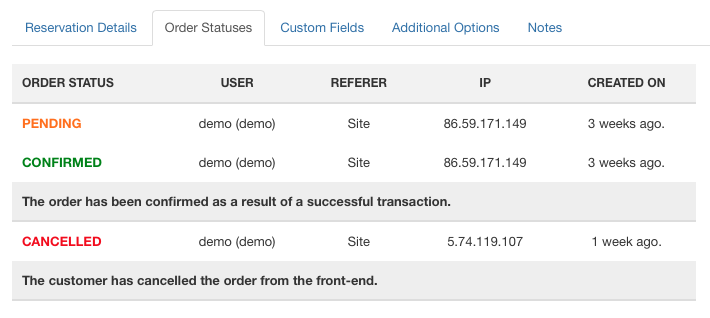
It is also possible to change the status manually and to add a custom comment as reminder.

Make Recurrence
You can create a recurrence for an order by selecting it and clicking the Make Recurrence button on the Joomla toolbar.
It is possible to create a recurrence only for a reservation per time. It is not possible to create a recurrence for PARENT orders.
Before to create the recurrence you are asked to specify the time arguments:
Repeat Every [Day, Week or Month] For the Next [Amount][Days, Weeks or Months].

You can get a preview of the available and occupied dates by clicking the Get Recurrence Preview button, which will load immediately a list with the calculated dates and their statuses. A reservation results as not available when there is already a stored appointment for that date and time or if that date and time are not contained in the working days of the employee/service.
In case of unavailable dates, the system will try to suggest other dates and times and/or other employees available at the same date and time.

The reservations will be stored only after clicking the Create Recurring Reservations button, which will display the number of created reservations. Notice that it will be created a reservation only for the available dates, while the occupied dates won't be considered.

Export
The orders can be exported by clicking the Export button from the Joomla toolbar. By default there are 3 different ways to export the orders: ICS, CSV and Excel. The appointments to export can be filtered by date (check-in), employee and by ID.
Leave the date filters empty to load all the existing appointments.
In order to filter the records by ID, flag the appointments you need to export from the list and then click the Export button.
ICS - iCalendar
The orders will be exported in a file following the standard structure of the iCalendar format. The exported file can be used to import the events (orders) within an external calendar handler. The exported file is compatible with all the most important calendar handlers, such as Apple iCal, Google Calendar, Outlook Calendar and so on.
From the configuration of the program it is possible to configure an automated ICS exportation in order to have all your calendars always up-to-date.
Here's a list of supported parameters:
- Subject - an optional title to be used for the events. The following placeholders will be replaced by the respective order detail: {service}. If not specified, the default subject will be used ("{service} - {customer}").
- Include Past Events - enable this option if you wish to keep all the existing appointments within the calendar. When disabled, appointments older than the current month won't be included.
- Reminder - if specified, the calendar will trigger a reminder/alert when the date time of the event is close to the current time.
CSV
The orders will be exported in a file following the standard structure of the comma-separated values format.
The exported file is compatible with all the most important spreadsheet applications (Open Office, Excel and so on).
Here's a list of supported parameters:
- Confirmed Status - enable this option to include only the approved appointments (confirmed and paid).
- Use Items - used to include the extra options within a separated column of the spreadsheet.
- Delimiter - the character that will be used to delimit the values of the table (a comma or a semicolon).
- Delimiter - the character that will be used to wrap the values of the table (a single quote or a double quote).
Microsoft Excel
Exports the rows in a (non-standard) CSV format compatible with Microsoft Excel.
Here's a list of supported parameters:
- Confirmed Status - enable this option to include only the approved appointments (confirmed and paid).
- Use Items - used to include the extra options within a separated column of the spreadsheet.

SMS Notifications
If you have configured the SMS APIs in the configuration of the program, you will see a Send SMS button on the Joomla toolbar.
The SMS message should contain a short description or a reminder about the appointment.This text can be specified from the SMS APIs configuration page.
To send a SMS you have to select at least a reservation and press a Send SMS button on the Joomla toolbar. The system will try to send a SMS to the phone number of each selected reservation. You will see a response about the status of the messages (success or failure).
Invoices
It is possible to generate the invoices of the appointments by clicking the Invoice button in the Joomla Toolbar. It is possible to generate multiple invoices by checking more than one reservation from the list. The system will generate the invoice only for the APPROVED orders (confirmed and paid).
Before to generate the invoices, the system will ask you if you need to send them automatically via e-mail to the address of the customers.
The generated invoices can be seen from the apposite Booking > Invoices page, from which it is also possible to issue the invoices monthly.
Closures
It is possible to use the Closures feature in order to stop receiving appointments for one or more employees on a range of time for a certain date.
The form used to block the appointments can be accessed by clicking the Block button on the Joomla toolbar.
- Employees - all the employees that should be blocked (at least one).
- Day - the date for which the employees should be blocked.
- From - the initial time of the closure (hours and minutes).
- To - the ending time of the closure (hours and minutes).
Every time you create a new closure, the system will display a closure record within the appointments' list.

Following the example in the previous image, John Brown won't be bookable on 2018-09-12 from 12:00 (included) to 20:00 (excluded).
Here's the result of this closure.
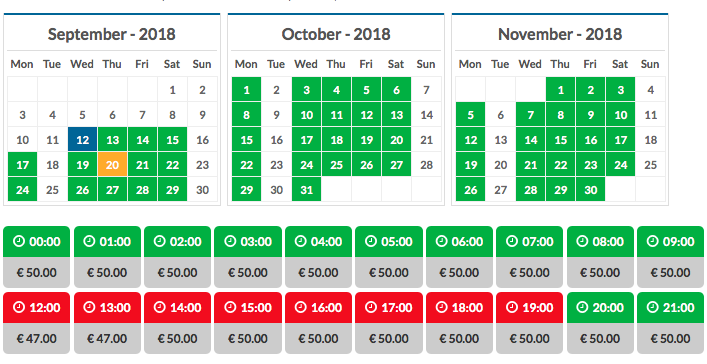
In order to remove a closure, you have just to delete the record from the list.
Waiting List
The Waiting List is an automated system to notify the customers that are waiting for a service in a specified date. In fact, every time a customer or the administrator cancel an order, the system will automatically send a notification via e-mail (and via SMS if a gateway is configured) to all the customers interested in that service for that date.
The customers can register themselves in a Waiting List from the details page of a service and from the details page of an employee by clicking the Add Me in Waiting List button. This button will be displayed only if the selected date contains at least a booked time.
When a row in the Waiting List becomes expired (the checkin day is in the past), it will be removed automatically from the system.
- Service - the service in which the customer is interested. This field is mandatory.
- Employee - the employee in which the customer is interested. This field is optional. When the employee is not specified, the customer will be notified for any cancellation related to the selected service.
- Checkin Day - the checkin day in which the customer is interested. This field is mandatory.
- User - the customer to assign in the waiting list. By specifying a user, the e-mail and the phone number will be automatically filled in (only if they are empty).
- E-Mail - the e-mail address of the customer, used as recipient for the notification. This field is mandatory.
- Phone Number - the phone number of the customer, used as destination for the notification via SMS. The phone number must contain the phone prefix before the address, by specifying the plus symbol and the prefix (+1). If the phone number is not specified or the SMS API gateway is not configured, the SMS won't be sent.
The Waiting List feature has to be enabled from the Shop configuration of VikAppointments first.
Customers
The customers view is used to collect all the details of your clients.
A customer will be created automatically every time a new logged-in client places a new order from the front-end.
Your users can edit their details by themselves from the All Orders view in the front-end, by clicking the My Profile button.
All the details contained in the Customer object are used to generate the invoices of the orders.
From the back-end, you can see the number of CONFIRMED appointments made by your customers and you can also sort them to see a best-purchaser ranking.
- User Account - the Joomla User assigned to this customer. If the customer doesn't have a Joomla User, you have to select the Guest option. By selecting the Create New Account option you will be asked to enter username, e-mail and password to create a new Joomla User. The Joomla User will be assigned automatically after saving.
- Name - the billing full name of the customer.
- E-mail - the billing e-mail address of the customer.
- Phone - the billing phone number of the customer. The phone prefix (like +1) must not be specified when country is selected.
- Country - the billing country of the customer.
- State/Province - the billing state/province of the customer.
- City - the billing city of the customer.
- Address - the billing address of the customer.
- Address 2 - a secondary optional billing address of the customer.
- Zip - the billing zip code of the customer.
- Company Name - the billing company name of the customer.
- Vat Number - the VAT Number of the customer.
- SSN / Fiscal Code - the social security number / fiscal code of the customer.
- Credit - the remaining user credit of a customer. This field is visible only in case the Enable User Credit setting is enabled.
- Expiration Date - it is possible to manually modify here the expiration date of the customer. As long as the subscription is not expired, this user will be able to book the assigned services for free.
- Custom Fields - the custom fields filled-in during the purchase. You can leave these fields empty if you are creating a new customer from the back-end.
- Notes - if you need to insert some additional notes about the customer, you can use this field. You will be able to see the saved notes from the notes history of this customer.
- Avatar - the image of the customer can be changed only by the customers within the front-end.
User Credit
The user credit is an amount that the customers can use to book the services without paying their costs. In case the cancellation is enabled, every time a customer cancels an appointment, an amount equals to the price of that appointment will be automatically added into its credit. So that it will be able to book a different appointment without paying anything else.
In order to use the user credit feature, the Enable User Credit setting within the Shop configuration must be turned on.
For example, if a customer has a credit equals to 40 €, we can face all these possibilities:
- it books an appointment that costs more than 40 €
- it books an appointment that costs 40 €
- it books an appointment that costs less than 40 €
In the first case, the user credit will be used to pay only a part of the total cost. Then, the remaining part will have to be paid again. In the second case, the user credit will be used to pay the whole total cost and the appointment will be automatically confirmed. In the third case, only a part of the user credit will be used to pay the whole total cost.
Notes & Documents
From the customers page in the back-end, it is possible to see the notes that have been assigned to a specific customer. The notes can be used to track a progress of the customers, write some reminders, save documents and files and so on.
- Title - an optional summary of the note. If not specified, the current date time will be used.
- Content - the body of the note, which supports HTML tags.
- Visibility - choose whether the note should be accessible by the customer too or whether it is for administrative purposes. Public notes assigned to the appointments are always included within the e-mail send to the customers and can be also found from the summary page of the appointments.
- Notify Customer - available only in case the visibility is set to Public. Check this option to send an e-mail to the customer, containing the title, the body and the attachments of the note.
- Tags - it is possible to assign the user note to specific tags, in order to improve the research of your existing notes. By typing a new tag that is not contained within the list, the system will automatically create it. The tags can be also managed from the list displaying the user notes, by clicking the Manage Tags button.
Attachments
Through the attachments fieldset it is possible to upload some files and documents. After uploading a file, it is possible to click it to show a popup. The popup lets you perform 3 different actions:
- Open - the file will be open in a new tab of the browser and will be displayed/downloaded according to the file mime type;
- More Info - displays the file details through an inspector;
- Delete - permanently deletes the file (remember to save the changes too).
Here's a list containing all the supported files:
- image
- png
- apng
- bmp
- gif
- ico
- jpeg
- svg
- video
- mp4
- mov
- ogm
- webm
- 3gp
- asf
- avi
- divx
- flv
- mkv
- mpeg
- wmv
- xvid
- audio
- aac
- m4a
- mp3
- opus
- wav
- ac3
- aiff
- flac
- midi
- wma
- ogg
- archive
- zip
- tar
- rar
- gz
- bzip2
- document
- doc
- docx
- rtf
- odt
- pages
- spreadsheet
- xls
- xlsx
- csv
- ods
- numbers
- presentation
- pps
- ppsx
- odp
- key
- text
- txt
- markdown
Import
It is possible to use the Import button within the Joomla toolbar to upload a list of customers contained in a CSV file. From this page it is possible to download a sample file to check how the customers should be structured.
The CSV file must contain at least the name of the e-mail of the customer.
Once the CSV file is ready, it is needed to upload it and press the green Import button. From the resulting page it remains to assign the columns of the records to the related values.

Export
It is possible to use the Export button within the Joomla toolbar to download all the customers stored in the system. After clicking that button, the system will show the first 10 records (and how they look) that will be exported. In order to export all the records, it is needed to click the Download button.
Before downloading the records you will be asked to select the format of the file. The system is able to export the records in SQL and CSV formats.
SMS Notifications
From the customers page you are able to send custom SMS notifications by clicking on the link under the Send SMS column.
Only the blue icons allow you to send a SMS. A Gray icon means that the customer doesn't own a phone number.
Within the popup you are asked to insert a short message (maximum 160 characters) that will be sent to the customer.
If you check the Remember option (keep this text as default), the message will be stored and will be displayed by default every time you want to send a message.
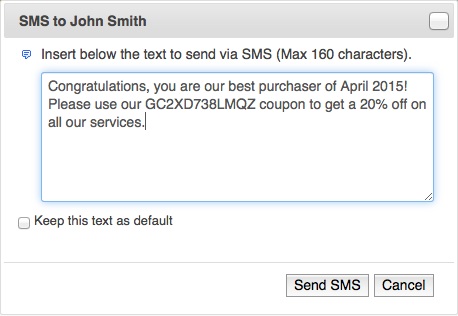
Coupons
The coupons are used to offer discounts to the customers during the purchase.
Coupons have to be applied before to save the order, within the confirmation page, and it is not possible to apply multiple coupons at the same time. If you try to enter 2 valid coupons, only the last one will be used.
There is no way to display coupons in the front-end, so you should promote them by yourself (e.g. through articles, modules, newsletters and so on).
- Code - the coupon code to use to be applied. When you create a new coupon, a random code will be generated automatically. If you want you can change it to make it more human-readable.
- Type - choose the type between Permanent option and Gift option. Permanent coupons remain on your system and can be used multiple times. Gift coupons can be used only for the specified quantity amount, then they will be automatically marked as expired (or, eventually, removed).
- Total Usages - the number of times that this coupon has been used.
- Max Quantity - the maximum number of usages for this coupon. This value is considered only for Gift coupons.
- Usages per Customer - it is possible to specify here the maximum number of times that the same user can redeem this coupon. In case of restrictions, only registered users are allowed to use the coupon.
- Applicable - select for which entity the coupon is applicable. Leave empty to apply the coupon for any shopping type.
- Auto Remove After Usage - when this option is enabled and the Quantity Used parameter reaches the Maximum Quantity, this coupon will be automatically removed from the system. Even if this option is disabled and the coupon is still active in your system, it won't be available. This option is considered only for Gift coupons.
- Percent or Total - choose if the value of the coupon is a total amount (like 20.00 €) or a percentage amount to discount on the total order (like, 220.00 € - 15%).
- Value - the amount of the coupon to discount.
- Minimum Cost - this restriction is used to apply the coupon only when the Total Cost of the order is equals or higher than this amount.
- Group - an optional group to categorize the coupon codes.
- Publishing Mode - the way the publishing dates are validated. It is possible to apply the coupon by checking the current date or the checkin date.
- Date Start - this restriction is used to apply the coupon only when the current/checkin date is equals or higher than this option. Leave it empty if you don't want to use this restriction. This restriction can be applied only if you specify also the Date End restriction.
- Date End - this restriction is used to apply the coupon only when the current/checkin date is equals or lower than this option. Leave it empty if you don't want to use this restriction. This restriction can be applied only if you specify also the Date Start restriction.
- Last Minute - enable this option if your coupon is "Last Minute". When you enable this option you will be asked to enter the "Checkin Within" value to determinate the maximum available date and time (by default 24 hours). In this way you can use the coupon only whether the checkin of the appointment is not after 24 hours from the current time.
- Notes - a short description for this coupon, which can be seen only by the administrator.
- Available Services - restrict the usages of this coupon only to the specified services. If no service is specified, it will result available for all the services in your system.
- Available Employees - restrict the usages of this coupon only to the specified employees. If no employee is specified, it will result available for all the employees in your system.
- Status - the status of a coupon is defined automatically evaluating the dates restrictions. The available statuses are:
- Valid, the coupon code can be used by the customers. The current date is between the dates restrictions or the restrictions are not specified and the quantity used is lower than the maximum quantity.
- Not Active, the coupon code cannot be used by the customers. The current date is lower than the Date Start restriction.
- Expired, the coupon code cannot be used by the customers. The current date is higher than the Date End restriction or the quantity used is equals than the maximum quantity.
In case the Publishing Mode is set to Current Date, the coupon code will be redeemed only whether the current date (at booking time) is between the specified dates. Otherwise, it will be applied only whether all the selected checkins are between the specified dates.
Groups
It is possible to create some groups in order to categorize all your coupons. In this way, it will be easier to search them. These groups may result helpful when the system owns a huge number of coupons.
The groups can be visited by clicking the Manage Groups button, located within the top-right side of the coupons page.
- Name - the name of the group.
- Description - a short description of the group.
Import
It is possible to use the Import button within the Joomla toolbar to upload a list of coupons contained in a CSV file. From this page it is possible to download a sample file to check how the coupons should be structured.
The CSV file must contain at least the coupon code.
Once the CSV file is ready, it is needed to upload it and press the green Import button. From the resulting page it remains to assign the columns of the records to the related values.

Export
It is possible to use the Export button within the Joomla toolbar to download all the coupons stored in the system. After clicking that button, the system will show the first 10 records (and how they look) that will be exported. In order to export all the records, it is needed to click the Download button.
Before downloading the records you will be asked to select the format of the file. The system is able to export the records in SQL and CSV formats.
Calendar
From this page you can see the availability calendar overview of all your employees. The availability calendar is referred to only one employee per time. To change employee you have to switch value from the dropdown.
Below each month you will see a quick report about the earning of the selected employee. If you are not able to see these reports you should click the Show Statistics button.
Every month displays the total earning and the total number of appointments, the total earning of the selected employee and the total number of appointments of the selected employee. Then there are these last reports divided per services.
If you want to see a quick list of the reservations in a certain day, it is possible to pick a date from the calendar to display a list on the bottom of the page. It is possible to see all the details of a reservations by clicking the link. If the list doesn't appear, there are no reservations on the selected date.
Daily View
By clicking the Switch to Daily View, the system will use a different layout to display the calendar. In fact, it will be displayed a table containing the appointments of the next 7 days.
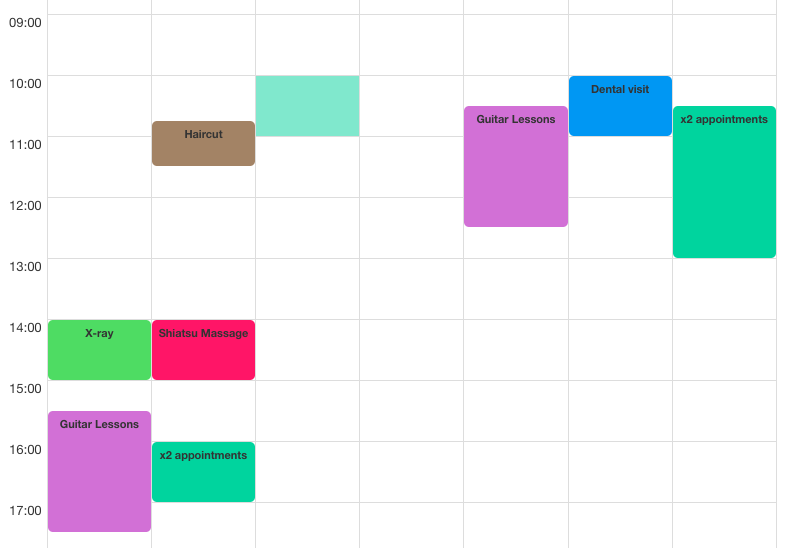
By clicking any appointment, the system will display the related details. In case of clustered appointments (appointments at the same date and time), the popup will contain the details of each appointment.
By clicking an empty cell, the system will show a table with the appointments only for the selected date. The only difference is that here the columns are represented by the employees (instead than the day). From this page, after clicking an empty cell again, the system will let you create a new reservation.
On the right side it is possible to see the list of services and all the appointments for the current range of dates. Next to the services it is possible to click the colored circle in order to change the background of the related appointments. Instead, within the list of appointments, it is possible to click the time in order to highlight the related appointment.
